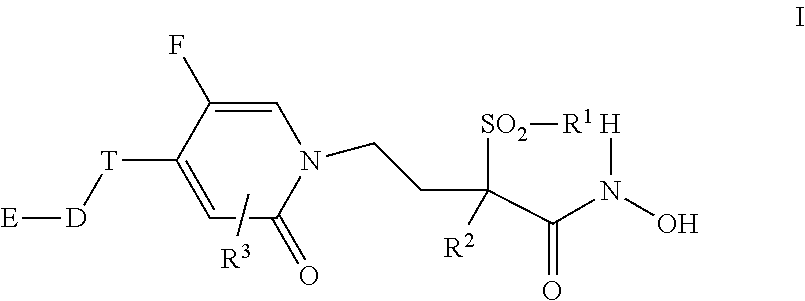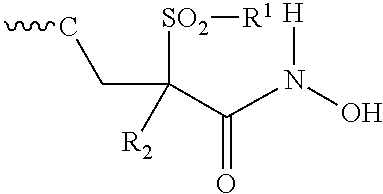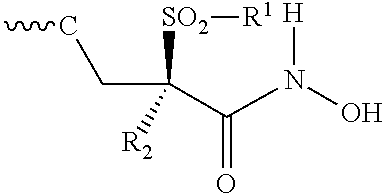Fluoro-pyridinone derivatives useful as antibacterial agents
- Summary
- Abstract
- Description
- Claims
- Application Information
AI Technical Summary
Benefits of technology
Problems solved by technology
Method used
Image
Examples
examples
Experimental Procedures
[0098]Experiments were generally carried out under an inert atmosphere (nitrogen or argon), particularly in cases where oxygen- or moisture-sensitive reagents or intermediates were employed. Commercial solvents and reagents were generally used without further purification, including anhydrous solvents where appropriate (generally Sure-Seal™ products from the Aldrich Chemical Company, Milwaukee, Wis.). Mass spectrometry data is reported from either liquid chromatography-mass spectrometry (LCMS) or atmospheric pressure chemical ionization (APCI). Chemical shifts for nuclear magnetic resonance (NMR) data are expressed in parts per million (ppm, δ) referenced to residual peaks from the deuterated solvents employed. Melting points are uncorrected. Low Resolution Mass Spectra (LRMS) were recorded on either a Hewlett Packard 5989®, utilizing chemical ionization (ammonium), or a Fisons (or Micro Mass) Atmospheric Pressure Chemical Ionization (APCI) platform which uses...
preparation 1
Synthesis of Template 1 (T1): Ethyl 4-bromo-2-methyl-2-(methylsulfonyl)butanoate and individual enantiomers (R) and (S)
[0201]
Step A) Ethyl 2-(methylsulfonyl)propanoate
[0202]Sodium methanesulfinate (103 g, 937 mmol) was combined with ethyl 2-chloropropionate (109 g, 892 mmol) in ethanol (350 mL) in a 500 mL one neck round bottom flask. The reaction was heated to 77° C. for 20 h, and then allowed to cool to room temperature. The solids were removed by filtration through celite, and the filter pad was washed with ethanol. The combined filtrates were concentrated in vacuo. The crude product was suspended in diethyl ether (250 mL), and solids were removed by filtration. The filtrate was concentrated in vacuo to afford the title compound as a pale yellow oil (51 g, 73%). 1H NMR (400 MHz, CHLOROFORM-d) δ ppm 1.32 (t, J=7.05 Hz, 3H) 1.67 (d, J=7.47 Hz, 3H) 3.05 (s, 3H) 3.83-3.92 (m, 1H) 4.18-4.37 (m, 2H).
Step B) Ethyl 4-bromo-2-methyl-2-(methylsulfonyl)butanoate
preparation 2
[0205]Scheme B illustrates the preparation of ethyl (2R)-4-(5-fluoro-4-iodo-2-oxopyridin-1(2H)-yl)-2-methyl-2-(methylsulfonyl)butanoate (T2) and (2R)-4-(5-fluoro-4-iodo-2-oxopyridin-1(2H)-yl)-2-methyl-2-(methylsulfonyl)-N-(tetrahydro-2H-pyran-2-yloxy)butanamide (T3) and the corresponding racemic and diastereomeric mixtures ethyl 4-(5-fluoro-4-iodo-2-oxopyridin-1(2H)-yl)-2-methyl-2-(methylsulfonyl)butanoate (T4) and 4-(5-fluoro-4-iodo-2-oxopyridin-1(2H)-yl)-2-methyl-2-(methylsulfonyl)-N-(tetrahydro-2H-pyran-2-yloxy)butanamide (T5).
Synthesis of Template 3 (T3): (2R)-4-(5-Fluoro-4-iodo-2-oxopyridin-1(2H)-yl)-2-methyl-2-(methylsulfonyl)-N-(tetrahydro-2H-pyran-2-yloxy)butanamide
[0206]
Step A) Compound III: 5-Fluoro-4-iodopyridin-2(1H)-one
[0207]Concentrated HCl (50 mL) was added to a mixture of 2,5-difluoro-4-iodopyridine (2.0 g, 8.3 mmol) in 1,4-dioxane (350 mL) and water (100 mL). The mixture was heated to reflux and stirred at this temperature overnight. The reaction was concentrated to...
PUM
| Property | Measurement | Unit |
|---|---|---|
| Magnetic field | aaaaa | aaaaa |
Abstract
Description
Claims
Application Information
 Login to View More
Login to View More - R&D
- Intellectual Property
- Life Sciences
- Materials
- Tech Scout
- Unparalleled Data Quality
- Higher Quality Content
- 60% Fewer Hallucinations
Browse by: Latest US Patents, China's latest patents, Technical Efficacy Thesaurus, Application Domain, Technology Topic, Popular Technical Reports.
© 2025 PatSnap. All rights reserved.Legal|Privacy policy|Modern Slavery Act Transparency Statement|Sitemap|About US| Contact US: help@patsnap.com



